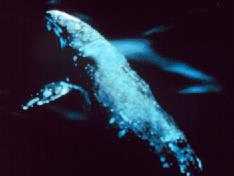|
The estimates used to determine the "original" population numbers are from the 19th century, just before commercial whaling began. New information in a study completed last year could mean that we shouldn't be content to cease protecting a species until it once again numbers in the millions.
In Florida a few years ago, the state wildlife agency proudly announced the removal of an alligator species from their endangered list. The way they expressed their joy was to reopen the hunting season for that majestic animal, welcoming the very thing that brought the animal to the brink of extinction in the first place.
Should the reason we restore species and habitats be so that we can destroy them again?
We have so few tools that enable us to deal with our environmental and social dilemmas. We are continually barraged by lists of acres, species, or habitats lost and how many pounds of one pollutant or another we place into the atmosphere.
Many are moved to alter their behaviors after seeing such numbers, but for how long?
Sure, such lists may encourage more recycling for a while, but do they have much affect on long-term lifestyle and behavior patterns?
Like the habitual dieter, moving from one fad diet to another, desperate to lose weight, we try recycling or water conservation. But like the dieter, who is doomed to failure unless she or he develops a relationship with the body he or she is trying to alter, we are doomed to failure unless we develop a relationship with the world around us.
I am convinced that it is not possible to care, really care, for someone or something without first developing a relationship with that person or thing.
Not seeing ourselves as having a constant, never-ending, dynamic relationship with the natural world around us may be our greatest obstacle.
Don’t allow the headlines and political posturing to amplify your feelings of hopelessness that you are alone in your values.
You are not.
But we all need to make it our obligation to get people to stand up for what is right.
Complacency will insure that our planet is plundered by those who care little for the future.
Psychologist and environmental scholar Joanna Macy warns us that numbers can be “numb-ers,” blinding and numbing us to the real issues.
The truth lies in our hearts and souls, not in a graph, chart, or headline.
|
